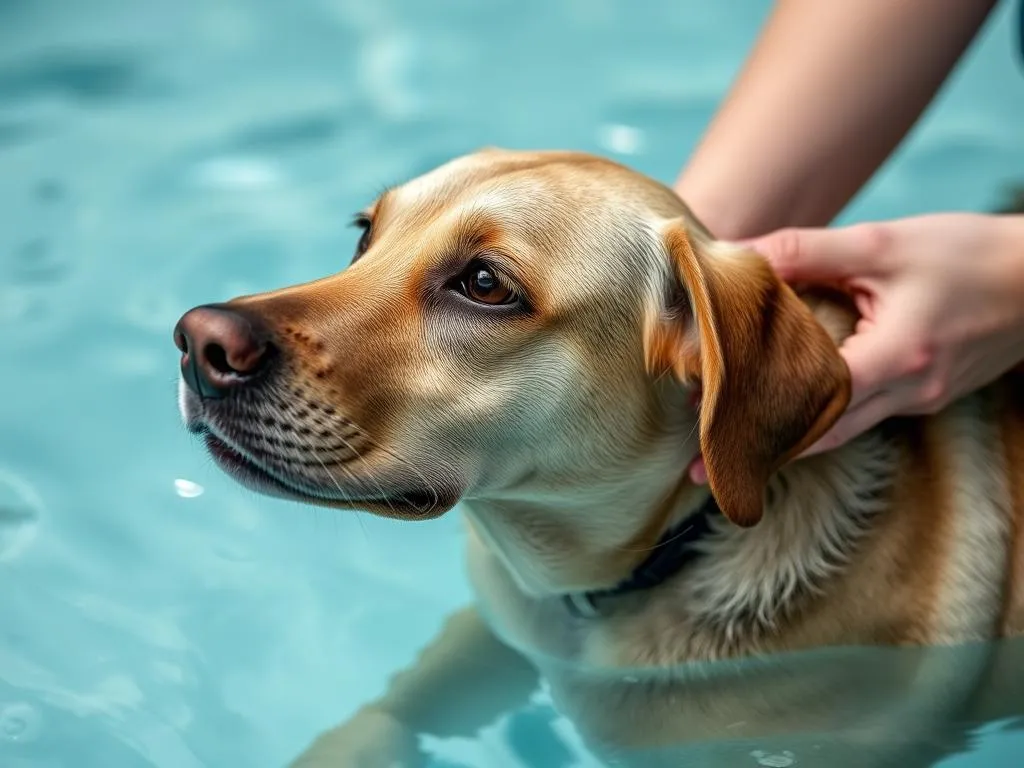
Introduction
Dog health care is a critical aspect of responsible pet ownership, encompassing various treatments and therapies designed to maintain and improve the well-being of our canine companions. One emerging treatment option gaining traction in the veterinary field is hydrotherapy for dogs. This innovative approach utilizes the therapeutic properties of water to aid in rehabilitation, pain management, and overall health improvement.
In this article, we will delve into what hydrotherapy is, how it works, and the myriad benefits it offers dogs. We’ll discuss when to consider hydrotherapy, how to find a suitable facility, and even options for home hydrotherapy. By the end, you will have a comprehensive understanding of how hydrotherapy can enhance your dog’s quality of life.
Understanding Hydrotherapy for Dogs
Definition of Hydrotherapy
Hydrotherapy is the use of water for therapeutic purposes, dating back to ancient civilizations where it was used to treat various ailments. Unlike traditional therapies that may involve medications or physical manipulation, hydrotherapy focuses on the properties of water—buoyancy, resistance, and warmth—to promote healing and recovery.
How Hydrotherapy Works
The science behind hydrotherapy relies on the unique characteristics of water. When a dog is submerged in water, the buoyancy reduces the strain on their joints and muscles, making movement easier and less painful. The resistance of water can enhance muscle strength and endurance, while the warmth can soothe sore muscles and improve circulation. Together, these elements create an ideal environment for rehabilitation and fitness.
Types of Hydrotherapy
Different methods of hydrotherapy are available, each offering unique benefits:
-
Underwater Treadmills: These specialized treadmills allow dogs to walk or run in water, effectively combining exercise with rehabilitation.
-
Swimming Pools: Swimming is a natural activity for dogs, and specially designed pools provide a safe environment for them to engage in this low-impact exercise.
-
Whirlpool Baths: These baths use jets to provide massage-like therapy, promoting relaxation and pain relief.
-
Hydrostatic Pressure Therapy: This method uses water pressure to support healing and reduce swelling, particularly useful for post-surgical recovery.
Health Benefits of Hydrotherapy for Dogs
Physical Rehabilitation
Hydrotherapy for dogs plays a significant role in physical rehabilitation, especially following surgery or injury. For instance, dogs recovering from orthopedic surgery often face challenges with mobility. Hydrotherapy can aid in their recovery by allowing them to exercise in a controlled environment, gradually rebuilding strength and flexibility. Many case studies highlight dogs that have successfully regained their mobility and returned to their normal activities following hydrotherapy sessions.
Pain Management
Chronic pain, such as that caused by arthritis or other degenerative conditions, can severely impact a dog’s quality of life. Hydrotherapy provides a gentle and effective means of pain relief. The warmth of the water helps to relax tense muscles, while the buoyancy alleviates pressure on joints. As a result, many dogs experience significant reductions in pain levels and an improved ability to engage in daily activities.
Weight Management
For overweight or obese dogs, hydrotherapy serves as an excellent tool for weight management. The resistance of water provides a low-impact workout that burns calories and builds muscle without putting undue stress on joints. Regular hydrotherapy sessions can help dogs shed excess pounds, leading to improved overall health and a lower risk of obesity-related diseases.
Enhancing Mobility and Joint Health
One of the standout advantages of hydrotherapy is its positive impact on joint health. The combination of buoyancy and resistance improves joint flexibility and strengthens the surrounding muscles. This is particularly beneficial for senior dogs or those suffering from mobility issues. Many pet owners report noticeable improvements in their dog’s ability to move and play after undergoing hydrotherapy.
Mental Health Benefits
Hydrotherapy does not only benefit dogs physically; it also promotes mental well-being. The combination of physical activity and the soothing properties of water can reduce anxiety and stress, leading to improved mood and behavior. Engaging in regular hydrotherapy sessions can help dogs feel more relaxed and content, enhancing their overall quality of life.
When to Consider Hydrotherapy
Indications for Hydrotherapy
There are several conditions for which hydrotherapy can be beneficial. Common indications include:
- Hip Dysplasia: A genetic condition affecting the hip joints, often leading to pain and mobility issues.
- Post-Surgery Recovery: Dogs recovering from surgeries, especially orthopedic procedures, can benefit from hydrotherapy to regain strength and mobility.
- Arthritis: Chronic pain from arthritis can be alleviated through the gentle movement facilitated by water therapy.
- Obesity: Dogs needing to lose weight can utilize hydrotherapy as a safe way to exercise without joint strain.
Signs that your dog may benefit from hydrotherapy include difficulty in movement, noticeable pain when walking, or a decrease in activity level.
Consultation with a Veterinarian
Before starting hydrotherapy, it’s essential to consult with a veterinarian. A professional can evaluate your dog’s specific needs and provide guidance on whether hydrotherapy is suitable. Questions to discuss during your consultation may include:
- What specific conditions can hydrotherapy address for my dog?
- How many sessions are typically recommended?
- Are there any risks or precautions I should be aware of?
Finding a Hydrotherapy Facility
What to Look For in a Facility
When seeking a hydrotherapy center, it’s crucial to find one that meets specific criteria:
- Qualified Staff: Ensure that the facility has trained professionals, such as certified canine rehabilitation therapists or veterinarians experienced in hydrotherapy.
- Equipment: Look for a center equipped with appropriate hydrotherapy tools, such as underwater treadmills, pools, and whirlpools.
- Cleanliness and Safety: A clean and safe environment is paramount. The facility should be well-maintained and equipped with safety features.
Evaluating Hydrotherapy Professionals
When evaluating hydrotherapy professionals, consider their credentials and certifications. Look for individuals with specialized training in canine rehabilitation and hydrotherapy. Experience is also critical; professionals familiar with various breeds and their unique needs will be better equipped to tailor treatments accordingly.
Cost Considerations
The cost of hydrotherapy sessions can vary widely based on location, facility, and services offered. On average, sessions may range from $30 to $100 each. It’s essential to budget for multiple sessions, as a consistent treatment plan often yields the best results. Inquire about insurance coverage, as some plans may cover hydrotherapy as part of canine rehabilitation.
Preparing Your Dog for Hydrotherapy
Pre-Session Preparation
Acclimating your dog to water is a crucial step before beginning hydrotherapy. Start by introducing your dog to shallow water gradually, allowing them to explore and become comfortable. If your dog exhibits anxiety or fear of water, consider using positive reinforcement techniques, such as treats and praise, to create a positive association.
What to Expect During a Hydrotherapy Session
During a hydrotherapy session, your dog will typically undergo a structured routine tailored to their needs. Sessions may involve warm-up exercises, followed by specific therapeutic activities like walking on an underwater treadmill or swimming. Safety measures such as life vests or harnesses may be used to ensure your dog is secure throughout the treatment.
Home Hydrotherapy Options
DIY Hydrotherapy Techniques
For pet owners looking to incorporate hydrotherapy at home, several simple techniques can be useful. Consider using:
- Kiddie Pools: Fill a small pool with water for your dog to walk or play in. Supervise closely to ensure safety.
- Sprinklers: Set up sprinklers in your yard to encourage your dog to engage in water play, providing both exercise and fun.
- Hydrotherapy Harnesses: These can assist in providing support during home water activities.
Cautions and Safety Tips
While home hydrotherapy can be beneficial, it’s essential to prioritize safety. Always supervise your dog during water activities to prevent accidents. Watch for signs of overexertion or stress, such as excessive panting, whining, or reluctance to continue. If any concerning symptoms arise, discontinue the session and consult a veterinarian.
Conclusion
Hydrotherapy for dogs offers a multitude of benefits, from physical rehabilitation and pain management to enhanced mobility and mental health. As a pet owner, considering hydrotherapy as part of your dog’s health care regime could significantly improve their quality of life. By understanding the various methods, benefits, and considerations surrounding hydrotherapy, you can make informed decisions that will help your furry friend thrive.
Frequently Asked Questions (FAQs)
What is hydrotherapy for dogs?
Hydrotherapy for dogs is a therapeutic treatment utilizing water to aid in rehabilitation, pain management, and overall health improvement.
How does hydrotherapy help dogs?
Hydrotherapy promotes healing through the buoyancy and warmth of water, reduces joint strain, enhances mobility, and can alleviate chronic pain.
What conditions can hydrotherapy treat?
Hydrotherapy can be beneficial for various conditions, including hip dysplasia, post-surgery recovery, arthritis, and obesity.
How can I prepare my dog for hydrotherapy?
Acclimatize your dog to water gradually, using positive reinforcement to help reduce anxiety.
What should I look for in a hydrotherapy facility?
Look for qualified staff, appropriate equipment, and a clean, safe environment when selecting a hydrotherapy center for your dog.









